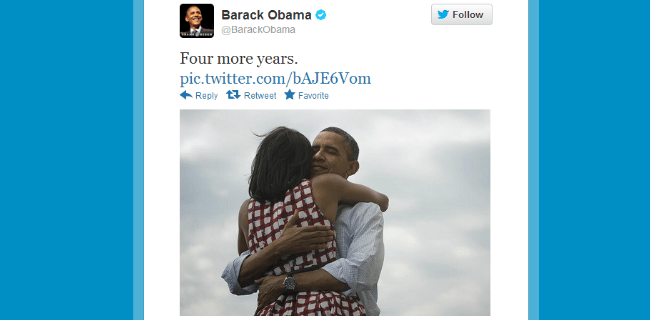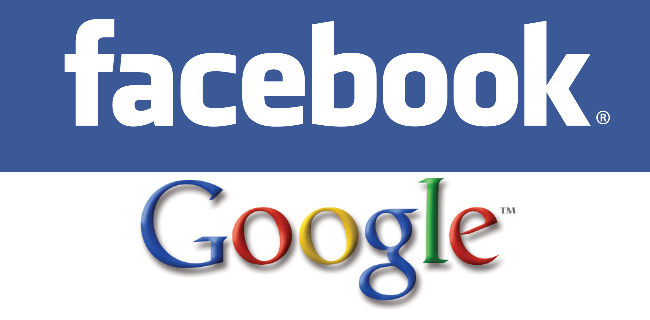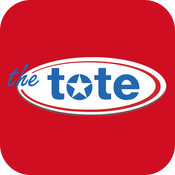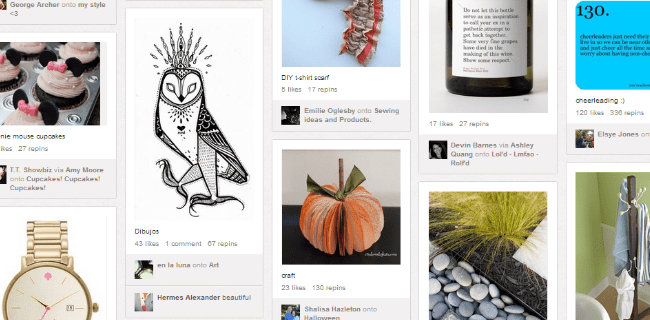8 Lessons Pinterest can Teach You about Online Business
Posted on November 10th, 2012 by Reginald Bailly in Digital NotesNo web startup has made a bigger splash in 2012 than Pinterest.
I?ve got 8 online business lessons from the amazing story of Pinterest below. But first, here?s a primer for the uninitiated.
What is Pinterest?
Pinterest was founded in 2010 by Ben Silbermann, Paul Sciarra, and Evan Sharp. It?s a social photo-sharing site that allows users to post groups of photos around certain themes or categories (a.k.a. ?pinboards?).
?Pinterest lets you organize and share all the beautiful things you find on the web. People use pinboards to plan their weddings, decorate their homes, and organize their favorite recipes.
?Best of all, you can browse pinboards created by other people. Browsing pinboards is a fun way to discover new things and get inspiration from people who share your interests.?
From Pinterest?s About Page
In January 2012, Comscore reported that Pinterest had 11.7 million unique monthly users ? making it the fastest website ever to top the 10 million mark. As of June, that number?s over 20 million.
The site?s users are a staggering 79% female, largely between the ages of 25 and 54.
How Does Pinterest Make Money?
As of now, it doesn?t.
In May 2012, Pinterest went through its third successful round of funding. The site raised $ 120 million from investors at a valuation of $ 1 billion to $ 1.5 billion.
Investors have a lot of reason to be optimistic about Pinterest?s monetization prospects. According to e-commerce firm RichRelevance, the average sale from a Pinterest user following an image back to its source is $ 180, compared to just $ 80 for Facebook users and $ 70 for Twitter users.
For a website that hasn?t yet even tried to monetize, its prospects are looking pretty rosy ? so much so that Fast Company said ?Pinterest looks like the future of e-commerce.?
What You?ll Learn:
- What Pinterest has in common with Barack Obama
- How Pinterest?s founders learned from their biggest rivals
- What Pinterest?s growth strategy has in common with Facebook
- The one value Pinterest places above all others
?
#1 ?Visuals Rule Today?s Online World

United States President Barack Obama broke the record for the most popular tweet of all time this Tuesday (Nov. 6, 2012). The text of Obama?s tweet was nothing special (?Four more years?). What pushed the tweet into the stratosphere was the picture that accompanied it (above).
The prominence of the image is manifest on Facebook too. According to Mashable, Facebook ?photos get as much as twenty times more engagement? than links, statuses, or videos.
While images are popular on Twitter and Facebook, they?re everything on Pinterest. The site owes much of its popularity to the fact that it all of its ?pins? are images arranged in a seamless, grid-based design.
?
#2 ?Stand on the Shoulders of Giants

From 2006 to 2008, Silbermann worked at Google?s advertising division doing customer support.
In 2010, just as Pinterest was launching, co-founder Evan Sharp took a job at Facebook.
Working with two of the world?s biggest, fastest growing websites surely informed Silbermann and Sharp as they steered Pinterest on its own course to gargantuan online success.
If you have a chance to learn from the best in your industry, take it.
?
#3 ?Learn from Mistakes
?Fall down seven times; get up eight.?
Japanese Proverb

In 2008, Silbermann quit his job working for Google and began a startup with his college friend, Paul Sciarra. They successfully raised seed funding and worked furiously on the project for over a year, but the resulting shopping app (called ?Tote?) never became popular. Worse still, the few people who were using Tote didn?t tend to make purchases with the app.
But what they were doing instead was even more interesting. Silbermann noticed that users liked to send themselves pictures of products that they liked so that they could see them again later. Embedded in that realization was the seed of the idea for Pinterest.
Of course, that?s just one lesson of hundreds that Silbermann and Sciarra must have learned while developing Tote. This is just another example of how so-called-failures are really stepping stones to success.
?
#4? Grow One Community at a Time
Here?s something Pinterest has in common with Facebook:? both started out as exlusive communities.
Facebook was initially just for Harvard Students. Only after Facebook became extremely popular at Harvard did Zuckerberg and crew open Facebook up to additional markets. They grew incrementally to include all Ivy League schools, then all universities, and eventually everyone in 2006.
Pinterest co-founder Ben Silberman ensured Pinterest started out as a small community by making the site invite-only. According to Fast Company, ?Many of the early invites went to a group of design bloggers whom Silbermann recruited personally. He gave each new user a limited number of invitations, urging them only to invite others whose taste they respected.?
Thanks to Silbermann?s selective savvy, Pinterest started out as a small community of visually adept designers. By giving them all a limited number of invitations, he encouraged organic social growth.
When stoking a fire, you must be careful not to smother the embers with too much kindling. Growing an online community requires a similar patience. Start with a small, exclusive, and loyal group of people; expand incrementally taking care never to scale too quickly.
On August 10, 2012 Pinterest was at last opened to everyone, no invitation required.
?
#5? User Experience is More Important than Page Views

Most online startups take the following for granted:? the more page views, the better.
It?s true that page views are an important metric to measure for an aspiring website. Each new view indicates increased popularity and potential for revenue from advertising.
Unfortunately, some websites overpursue page views, spreading their content over as many pages as possible in order to inflate their page view statistics. I know that I personally loathe it when sites make me click over and over again just to read one article. That?s why at Income Diary, we put the entire content of an article all on one page, even if it?s a list that?s 50 long.
Pinterest takes it one step further.
Silbermann and company recognized that the amount of time a person spent on their site and how engaging they found the experience were far better measures of long-term success than mere page views.That?s why Pinterest was one of the first big websites to utilize ?infinite scroll? on their home page. That means somebody could see literally thousands of ?pins? without once having to click a link or visit a new page.
The amount of page views a website gets is just a statistic. The quality of the user experience, on the other hand, plays a major role in how a person perceives and enjoys your web page. If you want long-term success, I recommend that you never trade page views for a worse user experience.
?
#6? You Don?t Have to be a Programmer
Mark Zuckerberg has said, ?My number one piece of advice is: you should learn how to program.? Facebook owes much of its success to that fact that Mark was able to code early versions of the site by himself.
In fact, most successful technology startups (including Google and Microsoft) were founded at least in part by programmers or computer engineers.
But here again, Pinterest bucks the trend. Silbermann holds a degree in political science. And while Evan Sharp had enough web development know-how to create the first versions of Pinterest (with the help of a hired-on engineer), he was going to graduate school to be an architect at the time.
Forbes reports that the lack of ?technical founders? initially limited investor interest. But Silbermann emphasizes that Pinterest?s early hurdles weren?t technical:? ?We didn?t have an engineering problem. We had a design and community problem.?
?I kind of think of engineering like the chefs at a restaurant. Nobody?s going to deny chefs are integrally important, but there?s also so many other people who contribute to a great meal.?
Ben Silbermann
Good programmers and engineers will always be vital to the success of online startups. But Pinterest has proven to the investors in Silicon Valley that a founder doesn?t need to be able to code a website in order to make it a runaway success.
?
#7? A Well-Curated Community is a Happy Community
Twitter, Facebook, and YouTube all operate under a similar paradigm; they see their users as creators.
Pinterest sees their users as curators. Instead of putting up their own content, a Pinterest user primarily uses the site to sift through the content of others and curate it by ?repinning? their favorite images to their own board.
According to Flowtown, 80% of ?pins? on Pinterest are ?repins?. Compare that to just 1.4% of tweets that are retweets.
For Pinterest, this means less self-promotional content, less overly-personal ?what I ate for breakfast this morning content?, and more of what people truly, objectively love out of hundreds of different options. As you read this, the Pinterest community is looking through an endless stream of images and rewarding their favorites with ?likes? and ?repins?.
The cream rises to the top and, in my experience, a quick visit to Pinterest?s home page is much more likely to yield something truly engaging than the often banal updates of Facebook and Twitter.
?
#8? Stay True to Your Values
Authenticity is one of Pinterest?s major values. On their about page under ?Pin Etiquette?, they advise their users ?be authentic? because, ?we think being authentic to who you are is more important than getting lots of followers. Being authentic will make Pinterest a better place long-term.?
Silbermann offered more insight into the value of authenticity in his interview with Fast Company. When writer Max Chafkin asked about how Pinterest could capitalize financially on the ?paid-for-pins? phenomenon (in which power Pinterest earn money from a company by plugging their products), Silbermann?s answer had nothing to do with monetization. Ben simply said, ?We?re just trying to preserve the authenticity. Pinterest is a young platform.?
Silbermann?s got his priorities in the right place. MySpace crumbled after it became a den for sleazy marketers. Facebook?s still going strong, but their recent foray into letting users pay to promote their personal posts indicates to me that they?ve forgotten what made their network beloved in the first place.
It will be interesting to see how Pinterest monetizes when the time comes. But it sounds like Silbermann and company will be very careful never to sacrifice their precious authenticity for more dollar bills.
?
Want to Know How to Get Traffic by Using Pinterest?
Josh Dunlop has written a pair of highly informative articles about how he drives 10,000?s of visitors to his photography blog through Pinterest. Josh says that he gets about five times more traffic from Pinterest than from Facebook and Twitter combined, even though his audience on Pinterest is a small fraction of the size.
If you?re thinking about getting started with Pinterest marketing, read Josh?s Beginner?s Guide to Seeing Massive Pinterest Traffic.
And if you?ve already had some success promoting your website with Pinterest, but you want to take it to the next level, he?s also detailed his Advanced Pinterest Marketing Strategies for Dominating Web Traffic.
?
How To Make Money Online
Source: http://www.gestbiz.com/8-lessons-pinterest-can-teach-you-about-online-business/
cbs news ny times karl rove Election 2012 Results polling place washington post yahoo news
No comments:
Post a Comment
Note: Only a member of this blog may post a comment.